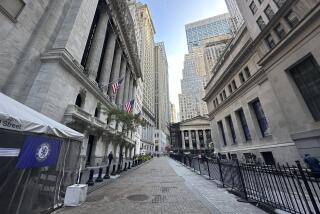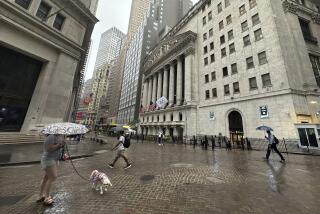The Tums Market: Has Volatility Reached Its Peak?
You have just lived through the most volatile period in modern U.S. stock market history.
Along with Shaq, you deserve that trip to Disneyland. But hurry back, because last week’s trend in the Nasdaq market suggests the action is heating up again.
Data crunched by Edward Kerschner, brokerage PaineWebber’s chief investment strategist in New York, confirm what many weary investors probably already assumed: The market’s daily swings were more dramatic in the first half of this year than in any year since at least 1940.
The hard numbers are truly striking:
* The Nasdaq composite index’s average daily move, including both up days and down days, was about 2.5% in the period Kerschner measured (Jan. 1 through May 14).
That was nearly four times the technology-dominated index’s annual average daily move of 0.67% since Nasdaq was born in 1971. “Nasdaq volatility is truly off the charts,” Kerschner says.
* The average daily move of the Standard & Poor’s 500 index from January through May 14 was about 1.2%. That was up from about 0.8% in 1999, and twice the historic average of 0.6%, measured back to 1940.
The scary thing is to extrapolate this year’s numbers. Nasdaq’s volatility has been double what it was in 1999. If the market were to stay on this track, therefore, the average daily move of the Nasdaq index next year would be about 5%. And in 2002, 10%.
The antacid industry would probably love those kinds of numbers for the twisted stomachs they’d cause. But the owners of those stomachs might have another viewpoint.
History, however, shows that wild deviations in volatility tend to be short-lived, Kerschner points out. And they have typically marked the end of major market declines--giving way to new bull markets, or at least to markets in which the price trend is up.
That was the case with the two highest volatility peaks in the S&P; 500 before this year’s record: in late-summer 1974, near the end of the horrendous two-year-long bear market fueled in large part by the record jump in oil prices; and in October 1987, when the market suffered its worst one-day crash in history.
But peaks in volatility are only obvious in retrospect. In other words, we don’t yet know whether we’ve reached the peak of crazed trading in this market cycle. (We’ve still got to assume the market is cyclical, although definitions of cycles, too, are different than they used to be, with market shifts happening so quickly.)
After a fairly calm June, Nasdaq was back to its old (new) self last week. The index plunged 3.2% on Wednesday amid a deep sell-off in semiconductor and software stocks. On Thursday, Nasdaq rebounded 2.5%, and on Friday it capped the week with a 1.6% gain.
Kerschner, probably like many investors, wonders whether Nasdaq in particular and the market in general have now become victims of the tremendous technological improvements we’ve celebrated so much in recent years.
“The Information Age has brought all information to all,” he notes. “But is information replacing knowledge? The ‘cost’ of the instant dissemination of information is the tendency to act first, think second. The quantification of the cost may be the increase in volatility, as even a minor bit of information elicits a major reaction.”
*
Consider last Wednesday’s 3.2% Nasdaq plunge. Based on what? Two software companies warned of earnings weakness in the near term, and a well-known semiconductor stock analyst said it’s his opinion that the chip industry could be nearing a peak in its boom cycle of the last two years.
Many other chip analysts don’t see a cycle peak any time soon, but their opinions didn’t register Wednesday. The voice of the moment held sway, and it got heard precisely because it was saying something different, if not necessarily something accurate.
Raging against market volatility and technological change, of course, is a rather futile exercise. The genie is out of the bottle. Some investors may choose to pay less attention to the daily barrage of market- and company-related news and opinions, but probably few would be willing to surrender access to that information entirely. Will you give up your Internet connection?
The optimistic spin on rising market volatility is that smart investors can use it to their advantage, buying stocks they like when the prices plummet for no fundamental reason, and selling out of soaring stocks whose price gains aren’t justified by the fundamentals.
But that tends to force all of us to be willing to play the trading game--or at least to stay tuned in to the daily market blather, in case opportunities present themselves.
*
Friday’s report on June employment trends showed the economy added 206,000 private-sector jobs in the month, fewer than expected. Wall Street’s rally, which left the Dow industrials up 1.8% for the week to 10,635.98 and Nasdaq up 1.4% to 4,023.20, suggested more investors are buying the idea of an economic soft-landing--i.e., growth slows, inflation stays subdued, the Federal Reserve terminates its campaign to raise interest rates, and the stock market . . . rallies?
That has been the pattern after every other cyclical peak in interest rates back to 1970, according to research by strategist John Manley at Salomon Smith Barney.
He looked at the stock market’s performance six months and 12 months after the major peaks in long-term interest rates that occurred in 1970, 1975, 1981, 1984, 1987 and 1994.
Manley used the 10-year Treasury note yield as a proxy for long-term rates. Typically, long-term yields peak before short-term rates, as the bond market rallies in anticipation of an eventual decline in the short rates the Fed controls.
Manley’s research shows that, in the six post-rate-peak periods he studied, the average gain in the Standard & Poor’s 500 index six months after the rate peak was 11.3%. The average gain 12 months after the peak was 24.7%.
This time around, the high point for the 10-year T-note, at least so far, was 6.79% on Jan. 20. By Friday the yield was at 6.02%, easing slightly from 6.04% Thursday on the employment news.
If the January high was indeed the peak for the T-note in this rate cycle, the S&P; will need to stage a strong rally by July 20 to match its historical average six-month gain after rate peaks: As of Friday, the index was up just 2.3% since Jan. 20.
Likewise, if major S&P; industry groups by next Jan. 20 are going to match their average 12-month gains following previous rate hikes, there’s going to be a hot time indeed in the market in the second half.
(BEGIN TEXT OF INFOBOX / INFOGRAPHIC)
If Rates Have Peaked ...
Let’s say you believe that the economy is indeed slowing, but not enough to fall into recession. You also believe that long-term interest rates have already peaked, anticipating the slowdown. Since 1970, the stock market has always been higher 12 months after a cyclical peak in long-term rates (as measured by the 10-year Treasury note). Here are the average gains in Standard & Poor’s stock sectors 12 months after rate peaks.
*
Source: Salomon Smith Barney
Data cover stocks’ performance after interest rate peaks of 1970, 1975, 1981, 1984, 1987 and 1994.
*
Tom Petruno can be reached by e-mail at tom.petruno@latimes.com
More to Read
Inside the business of entertainment
The Wide Shot brings you news, analysis and insights on everything from streaming wars to production — and what it all means for the future.
You may occasionally receive promotional content from the Los Angeles Times.










